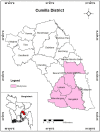Predictors Associated With Knowledge and Practice of Helminthic Infection Prevention Among Rural School-Aged Children's Parents in Bangladesh: A Cross-Sectional Study
- PMID: 33014978
- PMCID: PMC7498543
- DOI: 10.3389/fpubh.2020.00484
Predictors Associated With Knowledge and Practice of Helminthic Infection Prevention Among Rural School-Aged Children's Parents in Bangladesh: A Cross-Sectional Study
Abstract
Background: Parasitic infection has become a major public health concern in light of its increasing prevalence in developing countries, particularly in rural settings. Helminthic infections disproportionately affect children, and therefore appropriate parental knowledge and practical approaches to transmission prevention are essential. The objective of this study was to evaluate the level of knowledge and implementation measures aimed at preventing helminthic infection among rural school-aged children's parents in Bangladesh. Methods: A cross-sectional survey was conducted among the parents of 449 rural school-aged children residing in 17 villages of the Cumilla district in Bangladesh. Participants completed the survey examining socio-demographic variables as well as questions regarding knowledge and practice of helminthic infection prevention (HIP). Results: Local knowledge about children's HIP was inadequate among their parents (81.5%). Furthermore, actual implementation of HIP measures was poor (42.1%). Knowledge of HIP was significantly associated with parental religion, education, occupation, number of family members, family income, housing conditions, and sanitation system. In addition, practice of HIP was significantly associated with the aforementioned factors, as well as with water source and knowledge of HIP. Conclusion: Lack of concern about parasitic infection among children's parents and their untoward effects on children's health is pervasive in rural parental settings, along with ignorance on helminthic transmission and its prevention. Public education programs aimed at addressing these glaring HIP awareness deficits are needed in Bangladesh.
Keywords: Bangladesh; helminths; infection prevention; rural area; school-age children.
Copyright © 2020 Sujan, Islam, Naher, Banik and Gozal.
Similar articles
-
Health educational intervention by school nurses to prevent children's helminthic infection in Bangladesh: A cluster non-randomized controlled trial.J Educ Health Promot. 2024 Nov 29;13:441. doi: 10.4103/jehp.jehp_2060_23. eCollection 2024. J Educ Health Promot. 2024. PMID: 39811877 Free PMC article.
-
Nutritional status and prevalence of helminthic infection among primary school children in Bangladesh: A cross-sectional study.Jpn J Nurs Sci. 2024 Jan;21(1):e12568. doi: 10.1111/jjns.12568. Epub 2023 Oct 6. Jpn J Nurs Sci. 2024. PMID: 37800657 Clinical Trial.
-
Prevalence of intestinal parasitic infections and associated risk factors among schoolchildren in the Plateau Central and Centre-Ouest regions of Burkina Faso.Parasit Vectors. 2016 Oct 18;9(1):554. doi: 10.1186/s13071-016-1835-4. Parasit Vectors. 2016. PMID: 27756339 Free PMC article.
-
Direct Microscopy of Stool Samples for Determining the Prevalence of Soil-Transmitted Helminthic Infections among Primary School Children in Kaduwela MOH Area of Sri Lanka following Floods in 2016.J Environ Public Health. 2018 Jun 10;2018:4929805. doi: 10.1155/2018/4929805. eCollection 2018. J Environ Public Health. 2018. PMID: 29983716 Free PMC article.
-
Rural Children’s Health and Health Care, 2019-2020.2022 Feb. National Survey of Children’s Health Data Briefs [Internet]. Rockville (MD): Health Resources and Services Administration; 2018–. 2022 Feb. National Survey of Children’s Health Data Briefs [Internet]. Rockville (MD): Health Resources and Services Administration; 2018–. PMID: 38648334 Free Books & Documents. Review.
Cited by
-
Knowledge, Attitudes, and Practices regarding Soil-Transmitted Helminthiasis among Village Health Volunteers in Nakhon Si Thammarat Province, Thailand: A Cross-Sectional Study.Trop Med Infect Dis. 2022 Feb 19;7(2):33. doi: 10.3390/tropicalmed7020033. Trop Med Infect Dis. 2022. PMID: 35202228 Free PMC article.
-
Communities' knowledge, perceptions and preventive practices on soil-transmitted helminthes in Jimma, Oromia, Ethiopia: Formative mixed study.PLoS Negl Trop Dis. 2024 Sep 20;18(9):e0012483. doi: 10.1371/journal.pntd.0012483. eCollection 2024 Sep. PLoS Negl Trop Dis. 2024. PMID: 39302891 Free PMC article.
-
Intestinal parasitic infections among children aged 7-14 years in Mizan-Aman city, Southwest Ethiopia: a community-based cross-sectional study.Front Public Health. 2024 Dec 24;12:1478293. doi: 10.3389/fpubh.2024.1478293. eCollection 2024. Front Public Health. 2024. PMID: 39776487 Free PMC article.
-
Health educational intervention by school nurses to prevent children's helminthic infection in Bangladesh: A cluster non-randomized controlled trial.J Educ Health Promot. 2024 Nov 29;13:441. doi: 10.4103/jehp.jehp_2060_23. eCollection 2024. J Educ Health Promot. 2024. PMID: 39811877 Free PMC article.
-
Prevalence of depression, anxiety and associated factors among school going adolescents in Bangladesh: Findings from a cross-sectional study.PLoS One. 2021 Apr 1;16(4):e0247898. doi: 10.1371/journal.pone.0247898. eCollection 2021. PLoS One. 2021. PMID: 33793610 Free PMC article.
References
-
- Karagiannis-Voules DA, Biedermann P, Ekpo UF, Garba A, Langer E, Mathieu E, et al. . Spatial and temporal distribution of soil-transmitted helminth infection in sub-Saharan Africa: a systematic review and geostatistical meta-analysis. Lancet Infect Dis. (2015) 15:74–84. 10.1016/S1473-3099(14)71004-7 - DOI - PubMed
-
- World Health Organization Soil-Transmitted Helminth Infections. (2020). Retrieved from: https://www.who.int/news-room/fact-sheets/detail/soil-transmitted-helmin... (accessed July 15, 2020).
-
- Mukutmoni M, Khanum H. Prevalence and risk factors of intestinal Helminthiasis among the children of Begun Bari slum, Tejgaon, Dhaka. Bangladesh J Zool. (2018) 45:123–9. 10.3329/bjz.v45i2.35707 - DOI
-
- Nath TC, Padmawati RS, Alam MS, Das S, Murhandarwati EH. Elimination of soil-transmitted helminthiasis infection in Bangladesh: knowledge, attitudes, and practices regarding mass drug administration. J Glob Health. (2018) 2:e2018017 10.29392/joghr.2.e2018017 - DOI
MeSH terms
LinkOut - more resources
Full Text Sources


